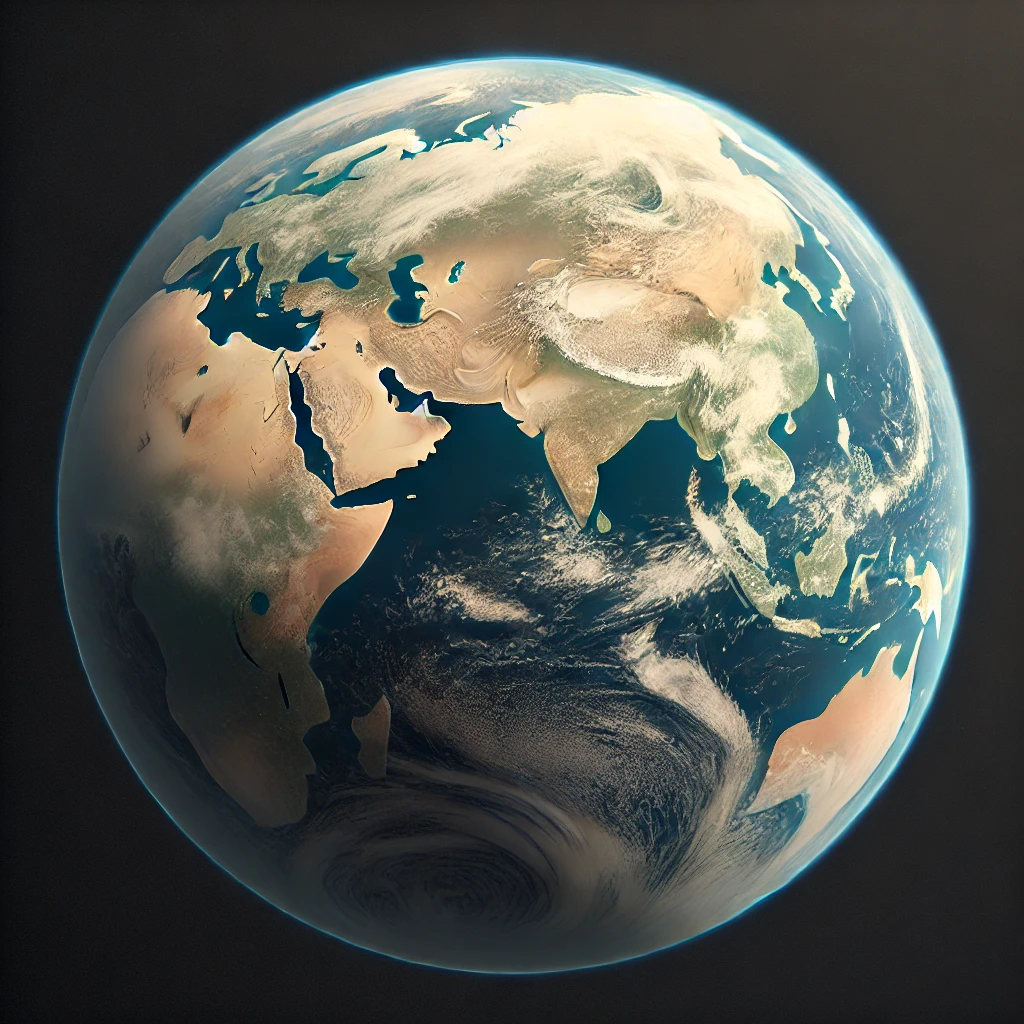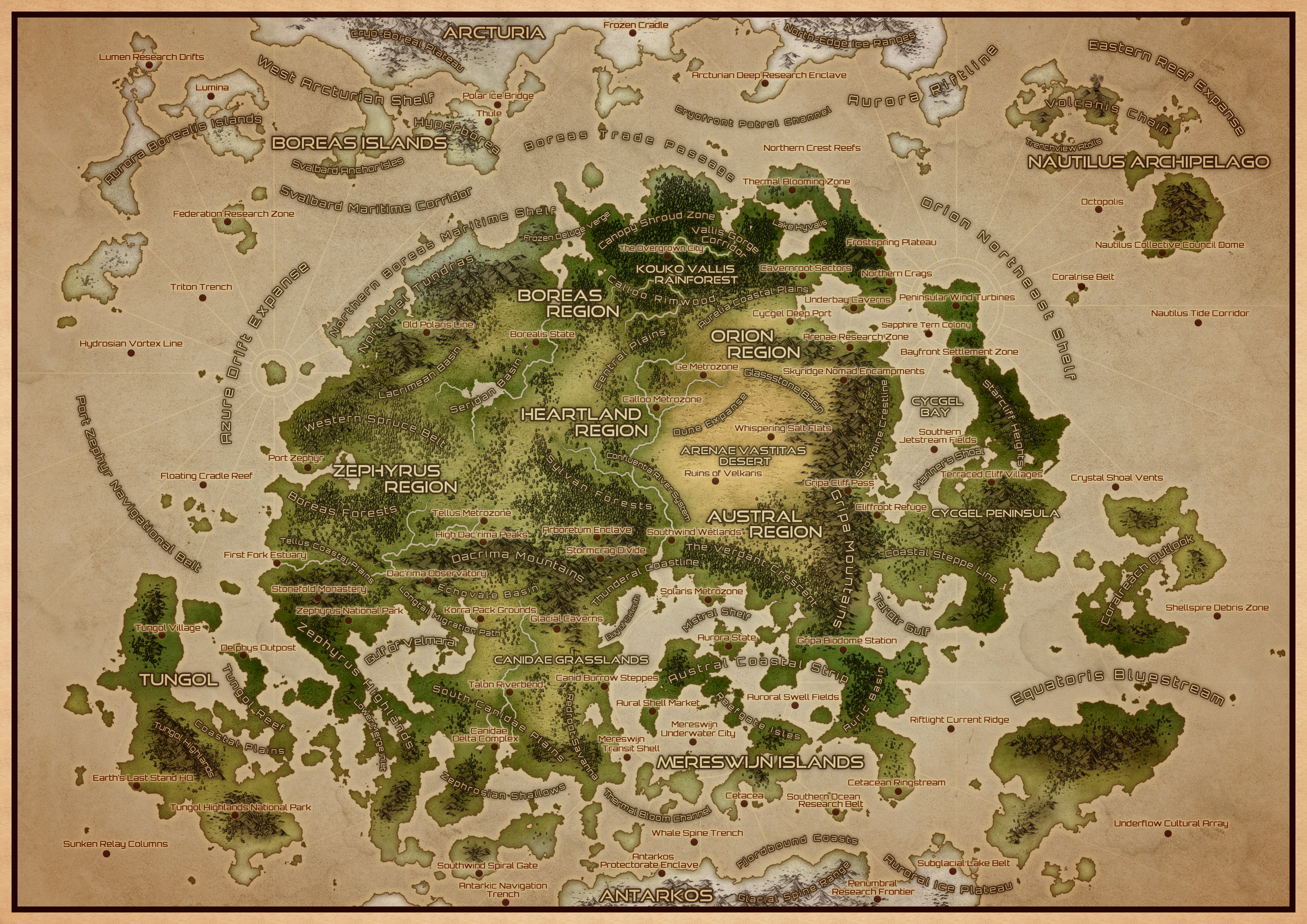Earth
Sol Solar System Planet
Earth is the third planet from the Sun in the Sol solar system and the cradle of human civilization. As of the year 28000 AD, it serves as the homeworld for several sapient species and a hub for intergalactic affairs within the Lumen Coalition of Unified Systems (LCUS). Located in the Orion Arm Sector and Sol Regional Cluster, Earth has undergone significant transformations since the cataclysmic events of the 2800s, yet retains its rich biodiversity and cultural heritage under the careful stewardship of its inhabitants.
Physical Characteristics and Geography
| Planetary Statistics | Values |
|---|---|
| Diameter | 12,742 km |
| Surface Area | 510.1 million km² |
| Land Area | 148.9 million km² (29.2%) |
| Ocean Area | 361.2 million km² (70.8%) |
| Axial Tilt | 23.5° |
| Rotation Period | 24 hours |
| Orbital Period | 365.25 days |
Earth's surface is dominated by the supercontinent UniTerra, which formed after the cataclysms of the 2800s. UniTerra encompasses approximately 85% of Earth's total land area and features diverse landscapes, from the towering Dac'rima Mountains to the lush expanse of the Kouko Vallis Rainforest. The planet is encircled by four major oceans - the Northern, Eastern, Southern, and Western oceans - which regulate its climate and support rich marine ecosystems.
UniTerra is divided into several distinct regions, each with unique characteristics:
- The Heartland Region in the center is the political, economic and cultural core. It includes major Lumen-dominated nations like Concordia and Promethea.
- The Orion Region along the eastern coast is a maritime trade and commerce hub.
- The western Zephyrus Region is a center of industry, technology and innovation.
- The northern Boreas Region is known for its rugged wilderness and natural resources.
- The diverse southern Austral Region is a hub of agriculture, mining, culture and art.
Other notable landmasses include the large subcontinent island of Tungol in the southwest, home to human holdouts maintaining traditional lifestyles, and numerous archipelagos like the Mereswijn Islands associated with Cetacean cities and the Nautilus Archipelago home to Cephalopod settlements. The polar regions contain the ice-covered landmasses of Arcturia in the north and Antarkos in the south.
Under Lumen stewardship, Earth's climate has been stabilized to maintain optimal conditions for its diverse inhabitants. The atmosphere is composed primarily of nitrogen (78%) and oxygen (21%), with trace amounts of other gases. Advanced technologies are employed to control atmospheric composition, ensuring a balance conducive to supporting life.
History
Earth's history is a complex tapestry of geological, environmental, and biological events that have shaped the planet over billions of years. Some pivotal eras and events include:
- Lemurian Civilization (50,000 BC - 30,000 BC)
- Atlantean Civilization (30,000 BC - 11,600 BC)
- Human Civilization (11,600 BC - 5,200 AD)
- The 2878 Environmental Cataclysms: A series of catastrophic ecological events, including massive supervolcano eruptions and devastating tectonic activity, reshaped Earth's surface and disrupted global ecosystems. The resultant changes set the stage for an unprecedented evolutionary radiation.
- Post-Cataclysmic Evolutionary Processes (2878 AD - 4280 AD): Earth's surviving species underwent rapid evolution and diversification, with novel ecosystems and hybrid flora and fauna emerging.
- Uplifted Earth Species (5,200 AD - 7,800 AD): The emergence of sapient Canines, Felines, Swine, Primates, Cetaceans and Cephalopods through clandestine uplift experiments.
- Chrono-Biogenesis Project and Lumen Emergence (7,800 AD): Genetic engineering of Humans into the advanced Lumen species.
- The Era of Lumen Ascendancy (7800 AD - 7900 AD): Transition from human to Lumen dominance on Earth.
- Earth Council Establishment (23,697 AD): Formation of a planetary parliament with representatives from each sapient species.
Ecosystems and Biodiversity
Earth boasts an incredible array of ecosystems and an unparalleled level of biodiversity. The planet's flora and fauna have evolved in remarkable ways, with many species achieving extraordinary sizes and adaptations.
Notable megaflora include:
| Species | Description | Ecological Role |
|---|---|---|
| Sequoia gigaeucalyptus | Hybrid tree reaching heights of up to 400 meters | Keystone species in post-cataclysmic forests |
| Ficus macrocosmicus | Massive tree with a spread of up to 10 hectares | Creates complex microhabitats |
| Dendrocalamus colossus | Giant bamboo species reaching heights of up to 100 meters | Plays a key role in reforestation |
| Rhizophora titanica | Colossal mangrove tree growing up to 80 meters tall | Crucial for coastal stabilization and carbon sequestration |
Notable megafauna include:
| Species | Description | Ecological Role |
|---|---|---|
| Elephas mammuthus sapiens | Gigantic proboscidean standing up to 8 meters tall | Keystone species and ecosystem engineer |
| Panthera omnis | Enormous felid reaching lengths of up to 6 meters | Apex predator and population regulator |
| Eunectes megaconda | Colossal snake growing up to 40 meters long | Top predator in aquatic and terrestrial environments |
| Struthio titanis | Towering flightless bird standing up to 6 meters tall | Important seed disperser and prey species |
Earth's ecosystems are characterized by complex trophic structures, nutrient cycling, and symbiotic relationships. The rapid ecological succession and climate resilience of these ecosystems have been key factors in the success of Earth's post-cataclysmic biosphere.
Sentient Species and Civilizations
Earth is home to several sentient species, each with unique cultures, social structures, and relationships to the planet's geography:
| Species | Population | Distribution |
|---|---|---|
| Lumens | 100,000 | Widespread, concentrated in major cities |
| Canines | 4 billion | Southern grasslands, urban centers |
| Felines | 3 billion | Cycgel Peninsula, maritime regions |
| Primates | 3 billion | Kouko Vallis Rainforest, urban centers |
| Swine | 2 billion | Nomadic groups, agricultural regions |
| Cephalopods | 2 billion | Nautilus Archipelago, underwater cities |
| Cetaceans | 2 billion | Mereswijn Islands, underwater cities |
| Humans (Holdouts) | 500 million | Tungol island, isolated communities |
The Lumens, despite their relatively small population, serve as the dominant species and custodians of Earth's evolution. They guide the development of the other sentient species, fostering ecological balance and promoting intercultural understanding.
Earth's societies are characterized by a complex tapestry of cultures, each with its own unique traditions, values, and social structures. However, under the influence of the Lumens, these diverse societies are united by a shared commitment to peaceful coexistence, knowledge sharing, and ecological stewardship.
The Earth Council, established in 23,697 AD, serves as a planetary parliament where representatives from each species gather to discuss global issues and foster intercultural relationships. The council plays a crucial role in promoting conservation efforts and celebrating Earth's rich ecological and cultural heritage.
Technology and Infrastructure
Earth's technology and infrastructure are designed to harmonize with nature, minimizing ecological disruption while optimizing functionality. Key features include:
- Eco-Integrated Technology: Buildings, Transportation Systems, and communication networks that blend with the landscape and utilize living materials.
- Renewable Energy Systems: Advanced technologies harnessing biofuels, kinetic energy, and subtle geoengineering.
- Seamless Transportation: Biological vehicles emulating living organisms and efficient public transit networks.
- Advanced Communication: Telepathic channels for Lumens and a planet-wide matrix supporting multiple interfaces and languages.
- Research and Development: Facilities focused on astrobiological and sociopolitical research, driving innovations in environmental sciences and interspecies technologies.
Economy and Trade
Earth's economy is underpinned by the principle of ecological symbiosis, where economic activities are designed to maintain and enhance the planet's ecosystems. Key aspects include:
- Tourism and Knowledge Economies: Ecological tourism and knowledge exchange are significant drivers of economic activity.
- Inter-species and Intergalactic Commerce: Carefully managed trade among Earth's species and with external entities, ensuring equitable benefits and ecological sustainability.
- Sustainable Exports: Advanced ecological technologies, agricultural innovations, cultural artifacts, and traditional wisdom.
- Cultural and Scientific Imports: Materials and technologies that enhance scientific understanding and cultural enrichment.
Natural Resources and Utilization
Earth's natural resources are characterized by their regenerative and renewable nature, with a strong emphasis on sustainable harvesting and management practices.
| Resource Category | Examples | Utilization Methods |
|---|---|---|
| Solar Energy | Photovoltaic arrays, solar thermal collectors | Habitat-integrated solar arrays, solar-powered transportation |
| Wind Energy | Wind turbines, kite power systems | Landscape-mimicking wind farms, airborne wind energy |
| Biomass | Algae, fast-growing crops, forest products | Sustainable aquaculture, permaculture, selective forestry |
| Geothermal Energy | Hot springs, geothermal wells | Geothermal power plants, direct heat utilization |
| Hydro Energy | Rivers, tides, waves | Eco-friendly hydroelectric dams, tidal and wave power generators |
The exploitation of Earth's resources is conducted with the utmost consideration for ecological balance, guided by advanced resource management protocols instituted by the Lumens.
Environmental Conservation and Challenges
Earth's inhabitants have developed a comprehensive approach to environmental conservation, focusing on the protection and rejuvenation of the planet's diverse ecosystems. Large expanses of Earth are designated as living museums and sanctuaries, serving as both protected areas and educational resources.
| Sanctuary | Location | Notable Features |
|---|---|---|
| Kouko Vallis Rainforest Preserve | Kouko Vallis Region | Towering arboreal colossi, rich biodiversity |
| Megalosuchus Sanctuary | Austral Region | Critically endangered megafauna, wetland restoration |
| Boreas Islands Marine Reserve | Northern Ocean | Pristine coral reefs, unique marine species |
| Tungol Island Wildlife Refuge | Tungol Island | Endemic species, human Holdout cultural heritage |
Despite significant progress in sustainable resource utilization and environmental conservation, Earth still faces various challenges, such as maintaining sustainable resource dynamics, fostering cultural integration among diverse sentient species, navigating climate regulation ethics, and developing effective mechanisms for conflict resolution and collaborative governance.
Conclusion
Earth in the year 28000 AD represents a remarkable fusion of ecological stewardship, technological advancement, and cultural diversity. Under the guidance of the Lumens and the collaborative efforts of its sentient species, the planet has emerged from its cataclysmic past to become a model of sustainability, harmony, and resilience. As Earth continues to navigate the complexities of its evolving existence, it serves as an inspiring example of what is possible when diverse species unite in the pursuit of a common goal: to create a future in which all life can thrive, and in which the bounty of the Earth is cherished and protected for generations to come.




Comments